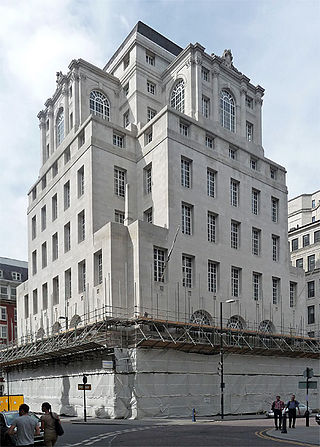
100 King Street, formerly the Midland Bank, is a former bank premises on King Street in Manchester, England. It was designed by Sir Edwin Lutyens in 1928 and constructed in 1933–35. It is Lutyens' major work in Manchester and was designated a Grade II* listed building in 1974.

St Ann's Church is a Church of England parish church in Manchester, England. Although named after St Anne, it also pays tribute to the patron of the church, Ann, Lady Bland. St Ann's Church is a Grade I listed building.

The Portico Library, The Portico or Portico Library and Gallery on Mosley Street in Manchester, England, is an independent subscription library designed in the Greek Revival style by Thomas Harrison of Chester and built between 1802 and 1806. It is recorded in the National Heritage List for England as a Grade II* listed building, having been designated on 25 February 1952, and has been described as "the most refined little building in Manchester".

Piccadilly Gardens is a green space in Manchester city centre, England, on the edge of the Northern Quarter.

The Kimpton Clocktower Hotel is a historic commercial building, now a hotel, at the corner of Oxford Street and Whitworth Street in Manchester, England. The building was originally constructed in segments from 1891 to 1932 as the Refuge Assurance Building.
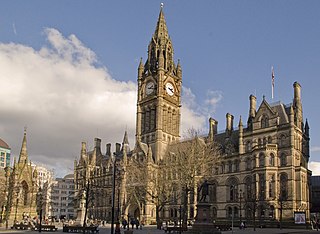
The architecture of Manchester demonstrates a rich variety of architectural styles. The city is a product of the Industrial Revolution and is known as the first modern, industrial city. Manchester is noted for its warehouses, railway viaducts, cotton mills and canals – remnants of its past when the city produced and traded goods. Manchester has minimal Georgian or medieval architecture to speak of and consequently has a vast array of 19th and early 20th-century architecture styles; examples include Palazzo, Neo-Gothic, Venetian Gothic, Edwardian baroque, Art Nouveau, Art Deco and the Neo-Classical.

Bridgewater House is a packing and shipping warehouse at 58–60 Whitworth Street, Manchester, England. It is recorded in the National Heritage List for England as a designated Grade II listed building.

Edward Walters was an English architect.
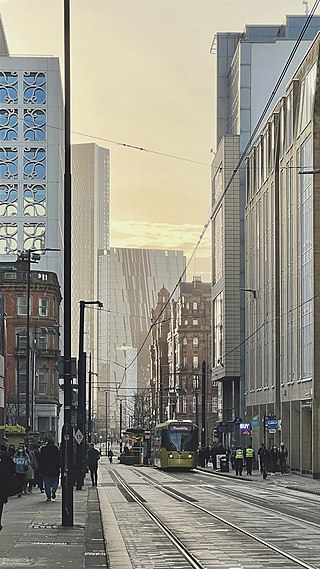
Mosley Street is a street in Manchester, England. It runs between its junction with Piccadilly Gardens and Market Street to St Peter's Square. Beyond St Peter's Square it becomes Lower Mosley Street. It is the location of several Grade II and Grade II* listed buildings.
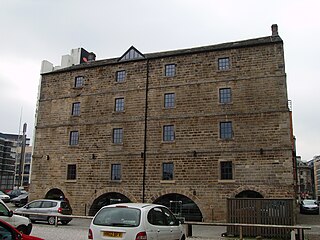
Dale Street Warehouse is an early 19th-century warehouse in the Piccadilly Basin area of Manchester city centre, England. It is a Grade II* listed building as of 10 November 1972. It is the earliest surviving canal warehouse in the city. The building is dated 1806 with the initials "WC" on the datestone, indicating that it was designed by William Crosley, an engineer who worked with William Jessop on the inner-Manchester canal system.

Minshull Street Crown Court is a complex of court buildings on Minshull Street in Manchester, England. The court was designated a Grade II* listed building on 2 October 1974. It is one of two Crown Courts in Manchester, the other being Manchester Crown Court.

Asia House at No. 82 Princess Street, Manchester, England, is an early 20th century packing and shipping warehouse built between 1906 and 1909 in an Edwardian Baroque style. It is a Grade II* listed building as at 3 October 1974. Nikolaus Pevsner's The Buildings of England describes the warehouse, and its companion, No. 86, Manchester House, as "quite splendid ... good examples of the warehouse type designed for multiple occupation by shipping merchants". It attributes its design to I.R.E. Birkett, architect of the Grade II listed companion building, Manchester House, which is similar in design. English Heritage attributes it to Harry S. Fairhurst. Asia House has an "exceptionally rich" entrance hall and stairwell, "lined with veined marble and green and cream faience, with designs of trees and Art Nouveau stained glass".

The Tootal, Broadhurst and Lee Building at No. 56 Oxford Street, in Manchester, England, is a late Victorian warehouse and office block built in a neo-Baroque style for Tootal Broadhurst Lee, a firm of textile manufacturers.

Royal Mill, which is located on the corner of Redhill Street and Henry Street, Ancoats, in Manchester, England, is an early-20th-century cotton mill, one of the last of "an internationally important group of cotton-spinning mills" sited in East Manchester. Royal Mill was constructed in 1912 on part of the site of the earlier McConnel & Kennedy mills, established in 1798. It was originally called New Old Mill and was renamed following a royal visit by King George VI and Queen Elizabeth in 1942. A plaque commemorates the occasion. The Ancoats mills collectively comprise "the best and most-complete surviving examples of early large-scale factories concentrated in one area".

The former National Westminster Bank on Spring Gardens, Manchester, England, is an Edwardian bank building constructed in 1902 for Parr's Bank by Charles Heathcote. The bank is in a "bold Edwardian Baroque" style. It is a Grade II* listed building as of 4 January 1972.
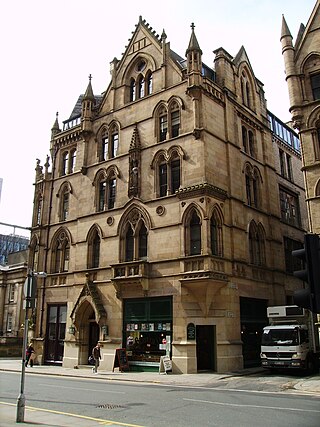
Lawrence Buildings in Mount Street, Manchester, England, is a Victorian office block constructed for the Inland Revenue in 1874–76 by Pennington and Bridgen in the Gothic Revival style. It is a Grade II* listed building as of 2 October 1974.

Brownsfield Mill, located on Binns Place, Great Ancoats Street in Manchester, England, is an early 19th century room and cotton-spinning power mill constructed in 1825. Hartwell describes it as "unusually complete and well preserved". The chimney is now Manchester's oldest surviving mill chimney. The building housed the A.V. Roe and Company aviation factory in the early 20th century. In 1988, it was designated a Grade II* listed building.

Spring Gardens is an important thoroughfare in Manchester city centre, England. This L-shaped street, formerly the centre of the North West's banking industry, has five Grade II listed buildings and is part of the Upper King Street conservation area.
Manchester is a city in Northwest England. The M13 postcode area is to the south of the centre of the city and includes parts of the districts of Chorlton-on-Medlock and Longsight. The postcode area contains 38 listed buildings that are recorded in the National Heritage List for England. Of these, one is listed at Grade I, the highest of the three grades, seven are at Grade II*, the middle grade, and the others are at Grade II, the lowest grade. The area includes the main buildings of the University of Manchester, some of which are listed, as are some hospitals. The area is otherwise mainly residential, and the other listed buildings include houses, some of which have been converted for other uses, churches and chapels, public houses, former public baths, a museum, a milepost, railings, a statue, and a war memorial.
Manchester is a city in Northwest England. The M2 postcode area of the city includes part of the city centre, including the Central Retail District. The postcode area contains 143 listed buildings that are recorded in the National Heritage List for England. Of these, five are listed at Grade I, the highest of the three grades, 16 are at Grade II*, the middle grade, and the others are at Grade II, the lowest grade.
























